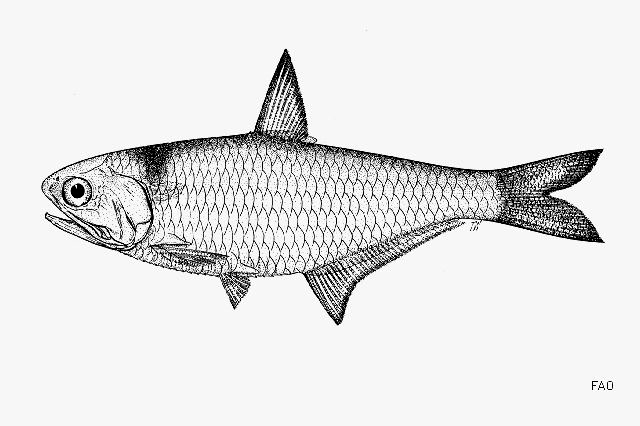Snubnose Thryssa, Thryssa nasuta (Castelnau 1878)
Other Names: Estuarine Thryssa, Snub-nosed Anchovy, Southern Anchovy

Illustration of a Snubnose Thryssa, Thryssa nasuta. Source: FAO / FishBase. License: CC BY Attribution-Noncommercial
Summary:
An anchovy with a diffuse saddle on the nape and no dark blotch behind the gill opening.
This species was previously known as Thryssa aestuaria (a junior synonym).
This species was previously known as Thryssa aestuaria (a junior synonym).
Cite this page as:
Bray, D.J. 2019, Thryssa nasuta in Fishes of Australia, accessed 05 Jul 2025, https://fishesofaustralia.net.au/home/species/2075
Snubnose Thryssa, Thryssa nasuta (Castelnau 1878)
More Info
|
Distribution |
Exmouth Gulf, Western Australia, to the Clarence River, Grafton, New South Wales. Elsewhere the species occurs in southern New Guinea. |
|
Features |
Anal fin 30-34. Belly with 14 to 16 + 8 or 9 = 22 to 25 keeled scutes from isthmus to anus. Maxilla short, reaching to hind border of pre-operculum; first supra-maxilla short, about half length of second. Pseudobranch very short. |
|
Species Citation |
Engraulis nasutus Castelnau 1878, Proc. Linn. Soc. N.S.W. 3(1): 51. Type locality: Norman River, Queensland, Australia. |
|
Author |
Bray, D.J. 2019 |
|
Resources |
Snubnose Thryssa, Thryssa nasuta (Castelnau 1878)
References
Castelnau, F.L. 1878. Notes on the fishes of the Norman River. Proceedings of the Linnean Society of New South Wales 3 (1): 41-51. See ref at BHL
Di Dario, F. 2017. Thryssa aestuaria. The IUCN Red List of Threatened Species 2017: e.T99079806A99079823. http://dx.doi.org/10.2305/IUCN.UK.2017-3.RLTS.T99079806A99079823.en. Downloaded on 08 July 2019.
Gill, A.C., Russell, B.C. & Nelson, G.. 2018. F.L. de Castelnau’s Norman River fishes housed in the Macleay Museum, University of Sydney. Zootaxa 4459(3): http://dx.doi.org/10.11646/zootaxa.4459.3.9
Grant, E.M. 2002. Guide to Fishes. Redcliffe : EM Grant Pty Ltd 880 pp. (as Thryssa aestuaria)
Hoedt, F.E. 2002. Growth in eight species of tropical anchovy determined from primary otolith increments. Marine and Freshwater Research 53: 859-867. (as Thryssa aestuaria)
Johnson, J.W. 1999. Annotated checklist of the fishes of Moreton Bay, Queensland, Australia. Memoirs of the Queensland Museum 43(2): 709-762. (as Thryssa aestuaria)
Larson, H.K., Williams, R.S. & Hammer, M.P. 2013. An annotated checklist of the fishes of the Northern Territory, Australia. Zootaxa 3696(1): 1-293 (as Thryssa aestuaria)
Ogilby, J.D. 1910. On new or insufficiently described fishes. Proceedings of the Royal Society of Queensland 23(1): 1-55. (described as Anchovia aestuaria) See ref at BHL
Whitehead, P.J.P., Nelson, G.J. & Wongratana, T. 1988. FAO Species Catalogue. Clupeoid fishes of the world (Suborder Clupeoidei). An annotated and illustrated catalogue of the herrings, sardines, pilchards, sprats, anchovies and wolf-herrings. Engraulididae. FAO Fisheries Synopsis. No. 125 Vol. 7 Pt 2. 305-579 pp. (as Thryssa aestuaria)
Whitley, G.P. 1941. Ichthyological notes and illustrations. Australian Zoologist 10(1): 1–50 figs 1–32 pls 1–2 (as Anchovia aestuaria)
Wongratana, T., Munroe, T.A. & Nizinski, M.S. 1999. Family Engraulidae. pp. 1698-1753 in Carpenter, K.E. & Niem, V.H. (eds). The Living Marine Resources of the Western Central Pacific. FAO Species Identification Guide for Fisheries Purposes. Rome : FAO Vol. 3 pp. 1397-2068. (as Thryssa aestuaria)

